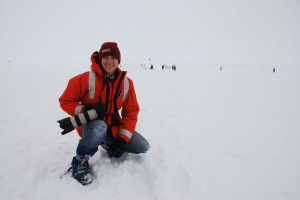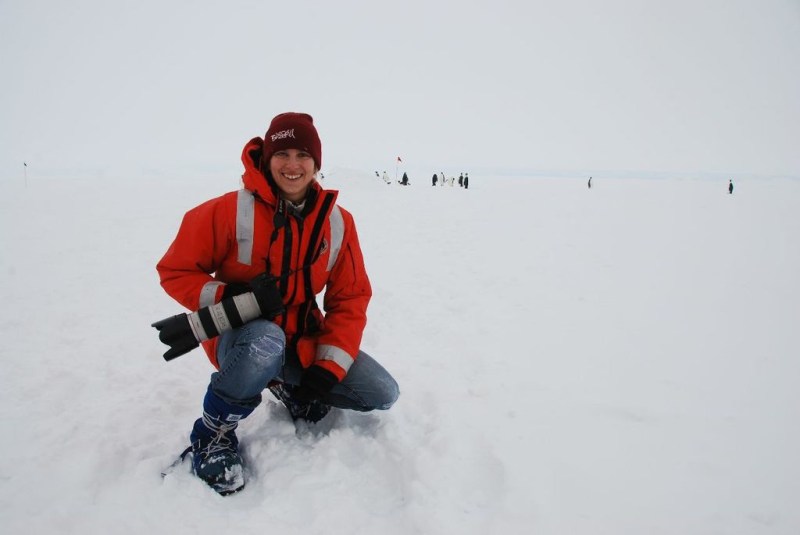Cassandra Brooks, a first-year doctoral student at the Emmett Interdisciplinary Program in Environment and Resources, recently completed a trip on an icebreaker vessel through the Ross Sea in Antarctica with the National Science Foundation (NSF). During her journey, Brooks researched marine protection and blogged for National Geographic; more recently, she posted a time lapse video on YouTube of the icebreaker traveling through the Ross Sea that has collected over 570,000 hits. The Daily sat down with Brooks to discuss her research, what it was like living on the icebreaker and what kind of response she has received from the YouTube video.

The Stanford Daily (TSD): Have you always been interested in marine biology, or did you discover your passion for it later in life?
Cassandra Brooks: I’ve always loved the ocean and always loved the little animals that live there. I was an obsessive tide-pooler, and whenever I could get to the ocean I would as a child… But sometimes I’m torn between outreach– working with people– and the science. And I think policy is a neat fusion of those things because you have to work with people, but you have to work with the science too, and you can hopefully have an impact on conservation… But Antarctica– I never would have dreamed I’d be able to go there. That was serendipity, and changed my whole life.
TSD: How long have you been blogging for National Geographic?
CB: This is my fourth trip to the Antarctic and usually I do some sort of blogging… I think it’s really important to provide a lens for not just my friends and family, though I love being able to show them, but also for the public. I wanted to step up this time so I actually pitched to National Geographic… I like to at least write a blog about each of my most amazing experiences.
TSD: What are the most memorable experiences that you have written about?
CB: When you’ve been in 24-hour daylight and all of a sudden the sun sets for the first time— it was so silly, but it was such a magical experience. It just felt so surreal… it just felt like touching infinity. I don’t know how to better say it than that. When you’re down there, you’re really experiencing the world without the buzz of cell phones and meetings, and all the stuff that really takes us away from our environment. So for me it’s always really grounding and reconnecting to be down there and to be experiencing the first sunset.
And the other highlight obviously was to be so close to emperor penguins. They’re huge birds, and they’re just absolutely amazing animals– they’re super inquisitive and curious, and they walk right up to you and check you out. And I don’t mean to humanize them– I wouldn’t want to do that– but the sensation we got was that they were coming up and checking us all out, and curious about this huge boat that suddenly showed up. More and more of them came everyday.
TSD: What kind of research are you doing in Antarctica, and why did you decide to do this research?
CB: It was a National Science Foundation trip that was paid for by the foundation and all the scientists on board basically wrote a grant together to do this work. And the big thing they wanted to do– they called it the “tracer’s cruise”– was basically trace this huge phytoplankton bloom in the Ross Sea. It happens every summer… it’s been studied, but what hasn’t been studied is what happens to all the phytoplankton, which is a huge source of carbon and a huge source of food to the environment. Where does it go? Does it get eaten right there? Does it sink to the bottom? Does it get transported elsewhere? So that was a big question we were interested in.
My background is in Antarctic marine science. However, in recent years I’ve been moving much more towards outreach and policy, and trying to inform policy especially in the Antarctic, and especially towards marine protection… I’m trying to understand how the policies and politics work in the Antarctic, and how are we going to achieve this huge feat of marine protection, with the ultimate hope of learning how we can better protect the Antarctic and make compromises between fishing and protection in this international space.
TSD: What is it like to live on an icebreaker?
CB: It was awesome. This was my first time on an icebreaker and it was really amazing. A big reason I wanted to do the video is that it was such an amazing sensation to stand there on the front of the boat or up on the bridge, and see the shape changing everyday– it was such a dynamic environment… it’s a place where humans haven’t damaged the environment, so it’s just an amazing place to be able to do research… The sounds– you hear the sounds of the shrieking steel on ice, and being on a boat that was so powerful was comforting, because I’ve been down there on boats that were far less strong. The boat we were on was super comfortable.
TSD: Are you surprised by how many people have watched your video? What kind of response have you received?
CB: I was super surprised. Usually I spend all this time making a video and my mom is the only one who gets excited about it, which is fine because I’m happy that she’s excited about it. But I posted it on a Friday morning and really just wanted to get it out there… and then literally overnight it went off the hook and I couldn’t tell you why… But I’m super happy because I think it’s provided a lens into Antarctica for people, and so often people wonder why we go down there, but now people are emailing me and saying how beautiful it is and understanding why I do research there. And especially now working towards marine protection in the Antarctic, I think it’s really important for people to see what an amazing landscape it is and to feel the place.
This interview has been condensed and edited.
